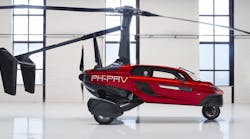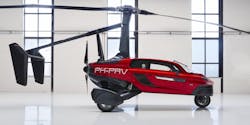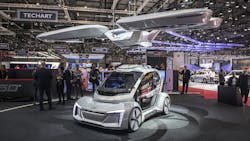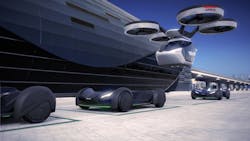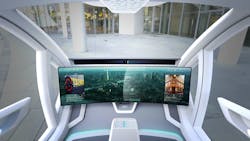I remember watching “The Jetsons” or “Back to the Future” thinking that flying cars would be cool. You just can’t get around that fact. Having a car that could transform from driving on the ground to flying the air would be an amazing way to travel.
Logistically, there are questions of air traffic and how to regulate flying cars. Are they street legal? Do they run on regular fuel? How can you land, and where? At this past month’s Geneva Motor Show, two different companies showed us how they plan to turn the fantasy of flying cars into a reality.
The Flying Pal-V Liberty
The Personal Air and Land Vehicle (Pal-V) Liberty vehicle is a runway take-off aircraft as well as a driveable land vehicle, offering the best of both worlds. It uses gyroplane design for stable flight and is certified by the FAA and EASA in Europe.
The Personal Air and Land Vehicle (Pal-V) Liberty vehicle has two seats, retractable helicopter blades, and is powered by a gasoline-fueled engine. The vehicle has a dual engine propulsion drive train, based on a two fully certified airplane engine from Rotax. The Pal-V Liberty is certified under both the EASA in Europe and the FAA in the U.S. The driver will need a pilot license to fly the vehicle.
On the ground, the speed range is 50 kilometers per hour up to 160 kilometers per hour (30 to 100 miles per hour). The top speed acceleration is just under nine seconds. The engine of 100 horsepower has a fuel economy of 7.61/100 kilometer with a range of 1315 kilometer (817 miles).
When in flying mode, the plane has gyroplane technology to maintain stable flight that provides safe landing even when there is total power failure. The take-off distance is 90 to 200 m (300 to 650 ft). Landing without an engine can be done with ±30 kilometer per hour ground speed. The design cannot stall, and crosswind landings are easier when compared to a fixed wing aircraft.
The aircraft needs a runaway space of 90 to 200 meters by 20 meters (100 to 650 ft by 60 ft) to take off and land. Runways designed for glider sites or ultralight aircraft will suffice. The max flying speed is 180 kilometers per hour (112 miles per hour) with a fuel range of 400 to 500 kilometers (249 to 311 miles) depending on the model.
The inside of the Pal-V Liberty offers a hybrid look of plane controls and a vehicle steering wheel.
“The Pal-V is the perfect product for city-to-city mobility,” said CEO Robert Dingemanse, highlighting that “outside the cities you fly, inside the city you drive.” The availability to fly is easy, he noted—well, at least in Europe. “You can use the 10,000 strips available in Europe, and because you can drive, that’s already enough,” Dingemanse said, adding that “every German will have a small airport within 10 or 20 kilometers of his home.”
The price point is not cheap. Future buyers will need to pay €10,000 to €20,000 ($12,000 to $25,000) for pilot training, in addition to the €300,000 to €500,000 ($367,914 to $613,120) for the vehicle itself. That’s the price of a small helicopter. The benefit, according to Dingemanse is that the Pal-V Liberty is “easier, maintenance costs are much lower, [and] it’s much more useful than a normal plane or helicopter.”
The Pop.Up Next from Airbus and Audi
The joint design of Airbus and Audi is the Pop.Up Next. It is designed as an electric vehicle autonomous shared driving service that has the ability for vertical take-off.
The power of a driving vehicle with autonomous driving was also on display at the Geneva Motor Show. Airbus and Audi introduced the Pop.Up Next, the follow to the Pop.Up now with self-driving technology on the road that can vertically lift into the air like a helicopter.
The vehicle is a two-seat passenger that has a 60-kW (80-hp) electric powered sled for autonomous driving on the ground. The top speed is 100 kilometers per hour (62 miles per hour) and the 15 kilowatt-hour battery has a 130-kilometer (81-mile) range.
The main body of the car mounts to sleds which provide ground transportation. The rider can then request an air module from a nearby charging station to dock with the main body, which detaches from the sled for vertical liftoff.
To fly, the vehicles connect to one shared network, where a passenger can request for the attachable air module. Air modules would be stored in nearby charging station and when requested would dock on to the top of car, disconnecting from the sled for vertical liftoff. The air module can fly 50 kilometers (31 miles) per charge. It is equipped with a 70 kilowatt-hour with eight electric motors and a top speed of 540 kilometer per hour (336 miles per hour).
Audi’s role, with the help of Volkswagen Italdesign, is to bring its autonomous vehicle and battery expertise into the design along with fine tuning the cabin’s interior. The inside features a 49-in. touchscreen that incorporates eye-tracking, speech, and facial recognition. The seats use a mix of aluminum framing and ultralight meshing to keep weight low.
Audi brings its expertise in autonomous driving and design to create a stylish and futuristic interior. The touchscreen detects eye movement, speech, and faces for a better interactive experience.
“This vehicle was not conceived to be sold to individuals, [but] as a shared means of transport,” said Mark Cousin, the project chief at Airbus. The company plans to launch the first urban trials in 2022 and hopes to expand its use cases into medical transportation of patients and goods.
